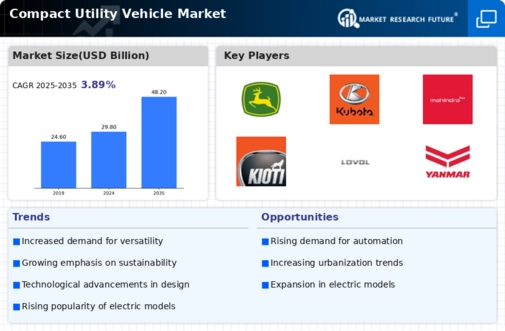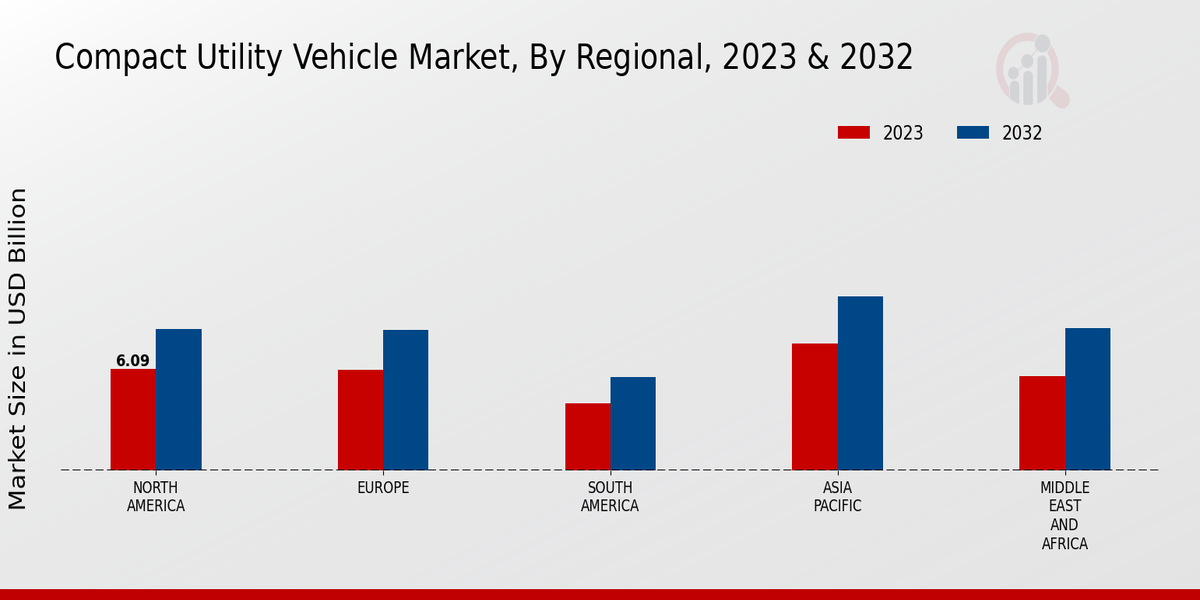Market Growth Projections
The Global Compact Utility Vehicle Market Industry is poised for substantial growth, with projections indicating a market value of 29.8 USD Billion in 2024 and an anticipated increase to 48.2 USD Billion by 2035. This growth trajectory suggests a robust demand for compact utility vehicles, driven by various factors such as urbanization, technological advancements, and changing consumer preferences. The industry is expected to experience a compound annual growth rate (CAGR) of 4.49% from 2025 to 2035, reflecting a positive outlook for manufacturers and stakeholders. These figures underscore the potential for innovation and investment within the compact utility vehicle sector.
Rising Demand for Versatile Vehicles
The Global Compact Utility Vehicle Market Industry experiences a notable surge in demand for versatile vehicles that can efficiently navigate urban environments while providing utility. Compact utility vehicles are increasingly favored for their ability to perform multiple functions, such as transporting goods and accommodating passengers. This trend is particularly evident in metropolitan areas where space is limited. The market is projected to reach 29.8 USD Billion in 2024, reflecting a growing preference for vehicles that combine functionality with compact design. As urbanization continues to rise globally, the appeal of these vehicles is likely to expand, driving further growth in the industry.
Sustainability and Environmental Regulations
The Global Compact Utility Vehicle Market Industry is significantly influenced by increasing sustainability and environmental regulations. Governments worldwide are implementing stricter emissions standards, prompting manufacturers to innovate and produce more eco-friendly vehicles. This shift towards sustainability is not only a regulatory requirement but also aligns with consumer preferences for greener options. As a result, many compact utility vehicles are being designed with electric or hybrid powertrains, which are expected to gain traction in the coming years. The industry's adaptation to these regulations may enhance its market position, potentially contributing to a projected CAGR of 4.49% from 2025 to 2035.
Technological Advancements in Vehicle Design
Technological advancements play a pivotal role in shaping the Global Compact Utility Vehicle Market Industry. Innovations in vehicle design, such as improved aerodynamics, lightweight materials, and advanced safety features, enhance the performance and appeal of compact utility vehicles. These advancements not only improve fuel efficiency but also contribute to overall vehicle safety, which is a growing concern among consumers. As manufacturers continue to invest in research and development, the introduction of smart technologies, including connectivity features and autonomous driving capabilities, is likely to attract a broader customer base. This trend may further solidify the industry's growth trajectory in the coming years.
Consumer Preference for Multi-Functional Vehicles
The Global Compact Utility Vehicle Market Industry is witnessing a shift in consumer preference towards multi-functional vehicles that cater to diverse needs. Today's consumers seek vehicles that offer flexibility, allowing them to transition seamlessly between personal and commercial use. Compact utility vehicles are increasingly seen as ideal solutions, providing ample cargo space without sacrificing maneuverability. This trend is particularly evident among small business owners who require reliable transportation for goods and services. As the market evolves, manufacturers are likely to respond by enhancing the versatility of their offerings, thereby attracting a wider audience and contributing to sustained growth in the industry.
Increasing Urbanization and Infrastructure Development
The Global Compact Utility Vehicle Market Industry is positively impacted by increasing urbanization and infrastructure development. As cities expand and urban populations grow, the demand for compact vehicles that can maneuver through congested streets becomes more pronounced. Infrastructure projects, such as road expansions and public transport enhancements, further facilitate the use of compact utility vehicles. This trend is particularly relevant in developing regions where urban centers are rapidly evolving. The industry's growth is expected to be robust, with projections indicating a market value of 48.2 USD Billion by 2035, driven by the need for efficient transportation solutions in urban settings.




















